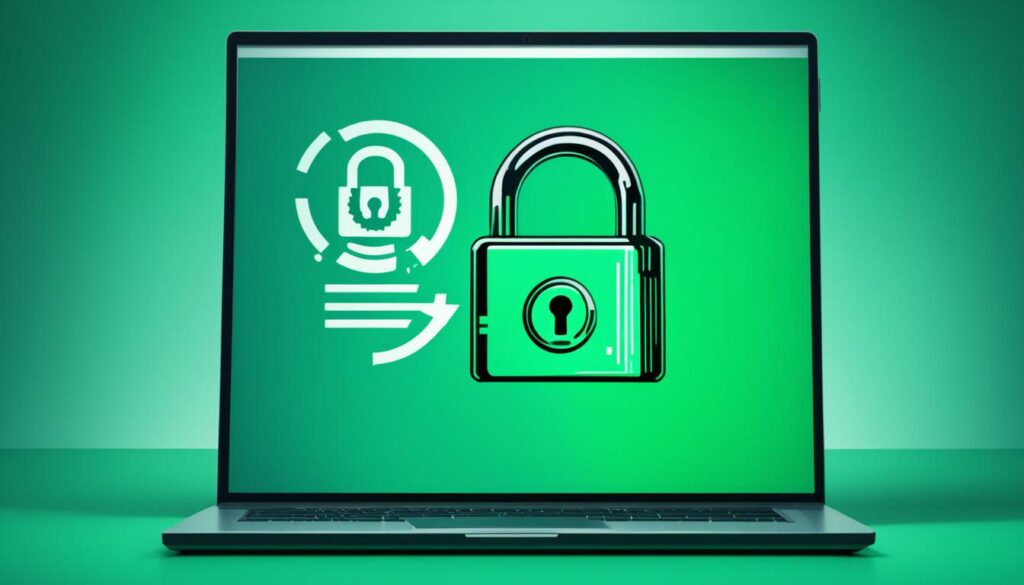In the rapidly evolving world of software development, a startling 70% of tested applications harbor code that has not undergone proper verification. This denotes a burgeoning need for setting up a secure code signing environment in the tech industry. Today, we peel back the layers to understand how a secure code signing environment setup not only fortifies digital assets but also fosters confidence among users.
In this digital era, the signature at the bottom of a document has transformed into a digital fingerprint embedded within our applications—our assurance of digital security measures. With every click on a download button, we place our trust in the invisible hands of code signing certificates. It’s crucial, then, that these guardians of authenticity are managed in an environment sealed tight against the prying eyes of cyber adversaries.
Key Takeaways
- Code signing certificates are essential for software authenticity and integrity.
- A secure setup is pivotal in protecting against code tampering and unauthorized alterations.
- Proper verification practices are the backbone of user trust in software security.
- Implementing stringent digital security measures is key in maintaining the sanctity of code signing certificates.
- Understanding the layers of setting up a secure code signing environment ensures robust protection against threats.
Understanding the Importance of Code Signing Certificates
In the digital landscape where trust is paramount, code signing certificates stand as the vanguards of software security. These certificates are not merely digital passes but foundational elements in assuring both developers and users that the integrity of the software remains intact from publisher to execution. Implementing code signing best practices is not just recommended; it is critical for maintaining the confidence that underpins today’s software distribution systems.
Definition and Purpose of Code Signing
At its core, a digital code signing certificate is akin to a virtual seal of approval. The primary role of these certificates is to authenticate the origin and confirm the integrity of digital software. With a valid signature, software publishers denote that the code has not been tampered with post-signing. This is a fundamental aspect of the code signing process, ensuring that what reaches the end user is precisely what was intended, untainted and secure.
How Code Signing Builds Trust in Software Distribution
Trust is the cornerstone of modern software distribution. In an era where malicious software is ever-present, code signing certificates serve as a beacon of trustworthiness. By affirming that the code delivered to the user is the unaltered work of a verified entity, these certificates mitigate fears of malware and data breaches. The weight given to these certificates in the users’ perceived safety cannot be overstated, highlighting the need for rigorous application of code signing best practices across the industry.
Understandably, trust translates into market dynamics. Developers who diligently use digital code signing certificates may find a more welcoming audience, as users learn to seek out this attribute as a marker of a safe, reliable software product. It’s a symbiotic relationship where security practices fuel user confidence which in turn drives adoption and distribution success.
| Aspect | Role | Impact |
|---|---|---|
| Authenticity Verification | Ensures the software’s publisher is verified and trusted | Increases software credibility and user trust |
| Integrity Assurance | Protects against unauthorized code modifications | Prevents distribution of corrupted or infected software |
| Non-Repudiation | Binds the digital signature to the publisher | Enables accountability and legal assurance |
In conclusion, the pivotal role of code signing certificates in the digital realm is a testament to their multifaceted importance in establishing a secure and trusted environment for software distribution. By adhering to the highest standards in the code signing process, we forge a path of security that benefits all stakeholders in the digital world.
What is a Digital Code Signing Certificate?
Often overlooked in the broader narrative of digital security, digital code signing certificates are the unsung heroes ensuring software security and user trust. These certificates play a pivotal role in the software distribution process by verifying the legitimacy of software publishers and protecting the integrity of their code.
Validation Types: Organization vs. Extended Validation Certificates
Digital code signing certificates can be divided into two main types based on the level of validation – Organization Validation (OV) and Extended Validation (EV). OV certificates are standard in the industry and provide a moderate level of authentication, verifying that the publisher is a legally accountable entity. On the other hand, EV certificates are the gold standard for secure code signing tools, offering the highest level of trust due to their rigorous validation process. Certificate authorities require additional checks for issuing EV certificates, making them the more secure option for entities that aim for maximum trust from their user base.
The Role of Certificate Authorities in Code Signing
The authentication process behind these certificates is managed by a critical player in the world of cyber security, the certificate authority (CA). CAs are responsible for issuing these certificates after a thorough verification of the applicant’s credentials. This endorsement from a respected CA serves as a bedrock for code signing security measures, reinforcing the authenticity of code and consequently, its publisher.

Below is a tabular comparison of OV and EV certificates which underscores the different levels of verification and security features:
| Feature | Organization Validation (OV) Certificate | Extended Validation (EV) Certificate |
|---|---|---|
| Level of Trust | Standard | Highest |
| Validation Requirements | Verification of organization’s existence and legitimacy | Comprehensive background checks including business operation verification |
| Issuance Time | Faster | Longer due to detailed vetting |
| Security Measures | Basic encryption and signature algorithms | Advanced encryption and rigorous signature algorithms |
| User Confidence | Confirms software authenticity | Enhances software credibility and provides higher assurance |
The Detailed Code Signing Process Explained
Delving deep into the intricacies of code signing is essential for establishing a trustworthy software distribution system. Every step from the initial certificate acquisition to the deployment of a secure application is crucial for a robust code signing environment setup.
Obtaining and Verifying a Code Signing Certificate
To initiate the code signing certificate management process, developers or organizations must select the appropriate level of validation for their certificate—Organization Validation (OV) or Extended Validation (EV). Following this selection, a trusted Certificate Authority takes over to verify the applicant’s credentials, ensuring the certificate holder’s identity aligns with stated claims, thus fortifying trust and security within the code signing ecosystem.

How to Install and Use Your Code Signing Certificate
Once the verification is complete, the next step in code signing key management is the installation of the certificate onto the developer’s preferred server or platform. The private key associated with the certificate becomes the linchpin of security, underpinning both the integrity and authenticity of the signed code.
As an integral part of the code signing environment setup, developers use the installed certificate to apply digital signatures to their software. This process secures the software’s code against unauthorized modifications, an assurance that is later confirmed by user systems during download through the use of public keys and trusted root certificates.
| Process | Description | Responsibility |
|---|---|---|
| Certificate Selection | Choose between OV or EV certificates based on desired level of trust. | Developer/Organization |
| Identity Verification | Verification of the entity’s legitimacy by a Certificate Authority. | Certificate Authority |
| Certificate Installation | Install the code signing certificate on appropriate server/platform. | Developer/Organization |
| Apply Digital Signatures | Sign software code with the private key to establish authenticity. | Developer/Organization |
| Verification by Users | Use of public key by user systems to validate the authenticity of the software upon download. | User’s System/Software |
This comprehensive approach to code signing certifies that the software being installed has not been tampered with and upholds the integrity of the code, thus streamlining processes for code signing certificate management, code signing key management, and overall confidence in the code signing environment setup.
Setting Up a Secure Code Signing Environment
As digital threats continue to escalate, setting up a secure code signing environment has become a non-negotiable aspect of software distribution. Such an environment is the foundation for maintaining software integrity and protecting against unauthorized tampering. Diligence in secure code signing environment setup helps ensure the digital safety of both producers and consumers alike.
The journey towards creating this secure environment begins with the management of private keys. By limiting access to keys and utilizing cryptographic hardware like Hardware Security Modules (HSMs), developers can create a robust bulwark against cyber threats. One should always consider using hardware that complies with FIPS-140 Level 2 standards to guarantee the enforcement of strong password protocols and additional security layers.
In addition to hardware solutions, an organization must also implement stringent policy frameworks that outline the usage of signing tools, the choice of certificates, and handling procedures. Updating these digital security measures regularly in accordance with the latest industry standards is essential to counter new threats effectively. The combined power of reliable hardware and comprehensive policies culminates in a fortified code signing process, critical to preempting risks of infringement and unauthorized access.

- Restrict private key access to authorized personnel only
- Deploy cryptographic hardware such as HSMs for added security
- Implement FIPS-140 Level 2 certified hardware to ensure strong password use and data protection
- Create detailed security policies to govern code signing activities
- Maintain regular updates to security measures in line with evolving technological standards
By diligently applying these protocols and safeguards, organizations can effectively construct a secure code signing environment as a pivotal part of their digital asset protection strategy.
Diving into Code Signing Best Practices
Implementing code signing best practices is paramount in today’s digital landscape where securing software integrity and trust is crucial. Understanding and applying rigorous code signing security measures can effectively safeguard the very foundation of digital trust.
Key Security Measures for Protecting Your Signing Keys
Securing the private keys involved in the code signing process is vital. Organizations are encouraged to adopt the best practices below to bolster code signing security:
- **Restrict Access**: Limit physical and digital access to private keys strictly to personnel vetted for their trustworthiness and understanding of code signing security protocols.
- **Strong Infrastructure**: Employ cryptographic hardware products, such as hardware security modules (HSMs), to establish a fortified barrier against the potential of private key exposure.
- **Separation of Environments**: Maintain distinct environments for test signing and release signing to mitigate risks and ensure a clear separation of internal and public-facing activities.
- **Rigorous Authentication**: Before the code signing process, implement procedures that ensure the software has not been tampered with or altered maliciously.
- **Extensive Logging and Auditing**: Develop an in-depth logging system for the entire code signing process, promoting transparency and facilitating any necessary audits.

The Necessity of Timestamping in Code Signing
Timestamping is an essential practice within the code signing process. It extends the validity of the code beyond the expiration date of the signing certificate and is crucial for:
- **Ensuring Longevity**: Timestamps can validate code signatures for extended periods, sometimes up to 11 years, enhancing the longevity and reliability of software.
- **Maintaining Compatibility**: Even after the signing certificate expires, timestamped software continues to remain compatible and trusted by end-users.
- **Upholding Trust**: By timestamping, developers can assert that the code remains unaltered since the time of signing, upholding the trust between the user and the software provider.
Adhering to these code signing best practices and security measures not only protects the integrity of software distribution but also underpins the confidence users have in digital platforms and products. As such, a well-documented and carefully implemented code signing process is a key differentiator for successful and trusted software providers.
Key Management in Code Signing Infrastructure
Effective management of keys within a code signing infrastructure is not just a recommendation; it is a requirement for maintaining software integrity and trustworthiness. Key management encompasses various practices and strategies that together form a defense against potential security breaches.
Strategies for Secure Key Storage and Access Control
The backbone of secure code signing certificate management lies in robust storage solutions, such as Hardware Security Modules (HSMs). These devices ensure that private keys, essential for the signing process, never leave the encrypted confines of the module. Access control further bolsters security, with detailed protocols dictating who can interact with these keys and under what circumstances. It is crucial to enforce policies that regulate the transportation and usage of keys, and these should always be transferred under the cloak of an encryption with strong, multifaceted passwords.

Planning for Key Compromise and Certificate Revocation
In the unpleasant event of a key compromise, quick and decisive action is indispensable. It’s essential to have an incident response plan detailed in the organization’s policy. This should outline the necessary steps to immediately revoke the compromised code signing certificate and notify the Certificate Authority. The policy must also cover the procedures for reporting the incident and taking measures to prevent further exposure or breaches within the code signing infrastructure.
| Consideration | Strategy | Tool/Action |
|---|---|---|
| Key Storage | Secure storage with limited access | Hardware Security Modules (HSMs) |
| Password Policy | Complex passwords with character variety | Password managers and policies |
| Certificate Revocation | Rapid response to compromised keys | Policies for immediate revocation |
| Incident Reporting | Detailed and swift communication to CAs | Maintained incident logs and contact procedures |
| Preventive Measures | Protocols for reducing breach impacts | Regular audits and security training |
By integrating these strategies and tools into your code signing infrastructure, you create a resilient environment capable of withstanding the challenges of digital security threats. With diligent code signing key management, the certifications and assurances offered by your software remain unimpeachable, preserving the confidence of your users and stakeholders.
The Importance of a Secure Code Signing Tools
In the landscape of software development and distribution, the emphasis on securing the code signing process cannot be overstated. With the advent of increasingly sophisticated cyber threats, utilizing secure code signing tools is paramount. These tools provide a foundational layer of security by ensuring that the software code remains untampered from the moment of its signing to the point where it reaches the end user.
When integrating code signing into the software release workflow, selecting the appropriate tools for code signing certificate management and verification process is essential. Developers and IT security professionals must carefully assess the features and capabilities of these tools to maintain stringent code signing security measures.
Choosing the Right Tools for Code Signing and Verification
Finding the right balance between ease of use and robust security is crucial when it comes to tools for code signing. It necessitates a combination of reliable hardware, sophisticated software, and adherence to best industry practices. Let’s delve into the characteristics that distinguish the most effective code signing tools available in the market.
| Tool Feature | Description | Security Benefit |
|---|---|---|
| Hardware Security Module (HSM) | A device that safeguards and manages digital keys for strong authentication. | Provides physical and logical protection for private keys, critical in preventing unauthorized access. |
| Certificate Authority (CA) Services | Trusted entities that issue and manage digital certificates for code signing. | Ensures the legitimacy of certificates and helps maintain a trusted code signing infrastructure. |
| Private Key Access Controls | Security protocols that regulate who can access private signing keys. | Mitigates the risk of key compromise by restricting access to authorized personnel only. |
| Signing Algorithm Support | Compatibility with advanced cryptographic signing algorithms. | Facilitates the use of more secure signing methods, offering better resilience against cyber threats. |
| Automated Certificate Lifecycle Management | Tools capable of handling certificate renewals, revocation, and rotation. | Cuts down on manual processes, reducing the risk of human error and maintaining continuity in security practices. |
Deploying tools that integrate seamlessly with development pipelines and support a broad range of platforms and programming languages is essential. This flexibility ensures that code signing checks are not bypassed due to tool incompatibility or cumbersome processes. As the digital landscape continues to evolve, the tools used for securing code signing processes must also be agile and up-to-date, ready to withstand and adapt to the changing nature of cyber threats.
Implementing Stringent Code Signing Certificate Management
In the digital realm, code signing certificate management is a pivotal component of creating a secure foundation for software dissemination. To maintain the trusted status of distributed software, organizations must deploy a meticulous and proactive approach towards managing their code signing certificates. A structured management system is not just about upholding security standards, but it also represents the commitment of an organization to safeguard the integrity of its digital offerings.
Best Practices for Handling Multiple Code Signing Certificates
As the scale of software distribution grows, so does the complexity of handling numerous certificates. It’s vital that businesses employ best practices in their code signing infrastructure to avoid pitfalls. These practices include close monitoring of certificates’ expiration dates, renewing them in advance to prevent any lapse in trust, and ensuring adequate documentation and training are provided to personnel involved in the code signing process. The goal is to have a seamless flow that guards against the consequences of expired or compromised certificates, which could undermine user confidence and the company’s brand.
Certificate Lifecycle Management: Renewal, Revocation, and Rotation
Certificate lifecycle management is the overarching strategy that underpins the effective administration of code signing certificates. Renewal protocols need to be adhered to religiously, with reminders set well before expiration dates. In instances of certificate compromise, a swift revocation must be executed to nullify any potential threats. Rotation of keys and certificates is equally essential in diffusing risks and enhances security multiple fold. By ingraining these elements into policy and practice, a business ensures continuity of trust and minimizes security gaps within their code signing environment.
FAQ
What are the steps to setting up a secure code signing environment?
Secure code signing environment setup includes obtaining a digital code signing certificate, implementing digital security measures, protecting private keys with hardware security modules (HSMs), enforcing strict access controls, and maintaining comprehensive logging for audits.
What is the purpose of a code signing certificate?
A code signing certificate establishes the authenticity of software by validating the identity of the software publisher and ensuring that the code has not been altered after it was signed. It helps in building trust among users when distributing software online.
How does code signing build trust in software distribution?
Code signing builds trust by providing a digital signature that verifies the software has not been tampered with since the publisher signed it. This assures users that the application is genuine and safe to download and use.
What are Organization Validation (OV) and Extended Validation (EV) certificates?
OV and EV certificates are types of digital code signing certificates. OV certificates confirm a publisher’s identity at a basic level, while EV certificates include additional security measures and undergo a more stringent validation process for issuing these credentials.
What role do Certificate Authorities play in code signing?
Certificate Authorities (CAs) verify the identity of entities requesting a code signing certificate and issue the certificate upon successful validation. They are crucial in maintaining the trustworthiness and security framework of code signing.
How do you obtain and use a code signing certificate?
To obtain a code signing certificate, you must select a type (OV or EV), go through the identity verification process with a CA, and then install the certificate on your server. To use it, digitally sign your software with a private key that corresponds with the certificate.
What are critical security measures to protect signing keys?
Critical security measures for protecting signing keys include using HSMs, enforcing access controls, isolating key environments, and implementing robust logging and auditing procedures to track key usage.
Why is timestamping necessary in code signing?
Timestamping in code signing is essential because it ensures that the software can be verified as trusted even if the code signing certificate has expired. It extends the validity of software verification and maintains software integrity over time.
What strategies are recommended for secure key storage and access control?
Recommended strategies include using cryptographic hardware like HSMs, ensuring that private keys are not exportable, enforcing strict password policies, and restricting access to keys to authorized personnel only.
What should an organization do in the event of key compromise or certificate revocation?
In the event of a key compromise, an organization should immediately revoke the compromised certificate, alert the Certificate Authority, rotate keys, and follow a predefined incident response policy to minimize impact and maintain security.
How do you select secure code signing tools?
Select secure code signing tools that are designed for maximum security, are compatible with your development platforms, and facilitate efficient management of the signing process and certificates. This may include HSMs and robust software solutions provided by reputable vendors.
What are the best practices for handling multiple code signing certificates?
Best practices include maintaining an inventory of certificates, monitoring expiration dates to ensure timely renewal, having protocols for key rotation and revocation, and educating team members on security policies and procedures.
How should one manage the lifecycle of code signing certificates?
Lifecycle management of code signing certificates entails routine surveillance of expiration dates for renewal purposes, prepared procedures for timely revocation in case of compromises, and key rotation to distribute risks associated with potential breaches.





